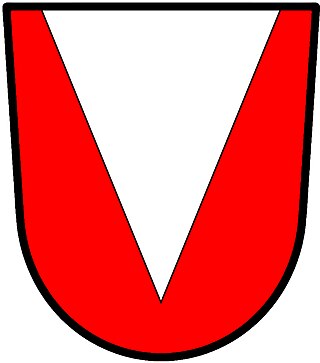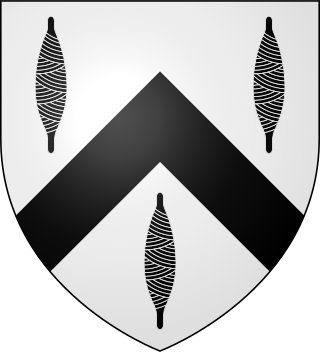Ordinaries in heraldry are sometimes embellished with stripes of colour alongside them, have lumps added to them, shown with their edges arciform instead of straight, have their peaks and tops chopped off, pushed up and down out of the usual positions, or even broken apart.

In heraldry, an ordinary is one of the two main types of charges, beside the mobile charges. An ordinary is a simple geometrical figure, bounded by straight lines and running from side to side or top to bottom of the shield. There are also some geometric charges known as subordinaries, which have been given lesser status by some heraldic writers, though most have been in use as long as the traditional ordinaries. Diminutives of ordinaries and some subordinaries are charges of the same shape, though thinner. Most of the ordinaries are theoretically said to occupy one-third of the shield; but this is rarely observed in practice, except when the ordinary is the only charge.

Trerice is an historic manor in the parish of Newlyn East, near Newquay, Cornwall, United Kingdom. The surviving Tudor manor house known as Trerice House is located at Kestle Mill, three miles east of Newquay. The house with its surrounding garden has been owned by the National Trust since 1953 and is open to the public. The house is a Grade I listed building. The two stone lions on the front lawn are separately listed, Grade II. The garden features an orchard with old varieties of fruit trees.

In heraldry, an ordinary is described as quadrate, when it has a square central boss.

The Bishop of Hereford is the ordinary of the Church of England Diocese of Hereford in the Province of Canterbury.
Joseph Austen Treffry was an engineer, mining adventurer, and industrialist who became a significant landowner in Cornwall, England.

In heraldry, a pile is a charge usually counted as one of the ordinaries. It consists of a wedge emerging from the upper edge of the shield and converging to a point near the base. If it touches the base, it is blazoned throughout.

Sir John Arundell (1495–1561), of Trerice, Cornwall, nicknamed "Tilbury Jack", was a commander of the Royal Navy during the reigns of Kings Henry VIII and Edward VI and served twice as Sheriff of Cornwall.

Anwyl of Tywyn are a Welsh family who claim a patrilinear descent from Owain Gwynedd, King of Gwynedd from 1137 to 1170 and a scion of the royal House of Aberffraw. The family motto is: Eryr eryrod Eryri, which translates as "The Eagle of the Eagles of Snowdonia. The family lives in Gwynedd and speak Welsh.
Cornish heraldry is the form of coats of arms and other heraldic bearings and insignia used in Cornwall, United Kingdom. While similar to English, Scottish and Welsh heraldry, Cornish heraldry has its own distinctive features. Cornish heraldry typically makes use of the tinctures sable (black) and or (gold), and also uses certain creatures like Cornish choughs. It also uses the Cornish language extensively for mottoes and canting arms.

Many different symbols are associated with Cornwall, a region which has disputed constitutional status within the United Kingdom . Saint Piran's Flag, a white cross on a black background is often seen in Cornwall. The Duchy of Cornwall shield of 15 gold bezants on a black field is also used. Because of these two symbols black, white and gold are considered colours symbolic of Cornwall.

The Trefusis family of Cornwall continue in 2018 as lords of the manor of Trefusis, near Flushing in the parish of Mylor, Cornwall, from which they took their surname at some time before the 13th century.

Sir Amyas Bampfylde of Poltimore and North Molton in Devon, England, was a Member of Parliament for Devon in 1597.
Coats of arms and seals of the County and Duchy of Cornwall, the Diocese of Truro, and of Cornish boroughs and towns.

Robert Carey, lord of the manor of Clovelly in North Devon, was Member of Parliament for Barnstaple, Devon, in October 1553 and served as Sheriff of Devon in 1555–56. He served as Recorder of Barnstaple after 1560. Along with several other members of the Devonshire gentry then serving as magistrates he died of gaol fever at the Black Assize of Exeter 1587. His large monument survives in Clovelly Church.

The landed gentry and nobility of Devonshire, like the rest of the English and European gentry, bore heraldic arms from the start of the age of heraldry circa 1200–1215. The fashion for the display of heraldry ceased about the end of the Victorian era (1901) by which time most of the ancient arms-bearing families of Devonshire had died out, moved away or parted with their landed estates.

Ash in the parish of Braunton in North Devon is a historic estate listed in the Domesday Book. The present mansion, known as The Ash Barton estate is a Grade II* listed building.
Budockshed is a historic estate in the parish of St Budeaux, near Plymouth in Devon, England.

Wortham is an historic manor within the parish of Lifton in Devon, England. The early sixteenth century manor house survives, today the property of the Landmark Trust. It was long the seat of the Dynham family, a junior branch descended from the Anglo-Norman magnate Baron Dynham. A mural monument survives in Lifton Church to John Dynham (d.1641) of Wortham, consisting of an escutcheon showing the arms of Dynham of Wortham impaling Harris of Hayne ) with the crest of Dynham above: An arm couped or hand azure holding a lock of hair sable, with an inscribed tablet beneath. John Dynham (d.1641) was the last in the male line and married Margaret Harris (d.1650), a daughter of Arthur Harris (1561-1628) of Hayne in the parish of Stowford and lord of the manor of Lifton, both in Devon, and of Kenegie in the parish of Gulval in Cornwall, Sheriff of Cornwall in 1603 and Captain of St Michael's Mount, Cornwall. Arthur Harris's grandfather John Harris (d.1551) of Hayne, a Serjeant-at-Law and Recorder of Exeter, had purchased the manor of Lifton from the Nevile family, Earls of Northumberland. John Dynham (d.1641) died without children whereupon his heir was his niece Mary Hex, a daughter of his sister Margaret Dynham by her husband John Hex of Alternon in Cornwall, who married John Harris of Lifton, consequently Wortham passed to the Harris family.

Joseph Hunkin (1610–1661) of Gatherleigh in the parish of Lifton in Devon, was Governor of Scilly between 1651 and 1660, during Parliamentary control in the Civil War.














